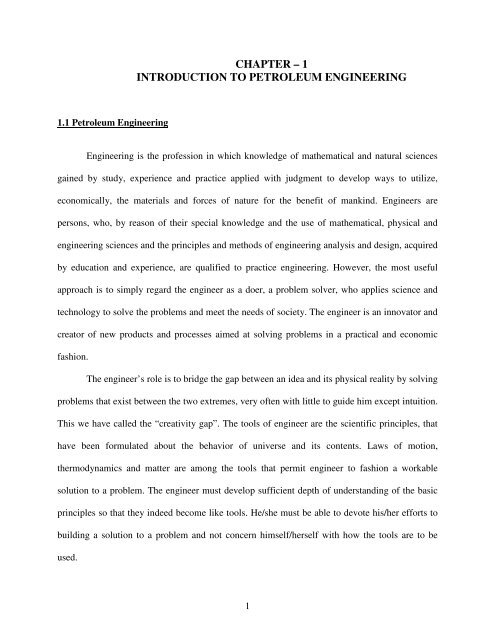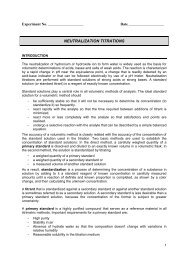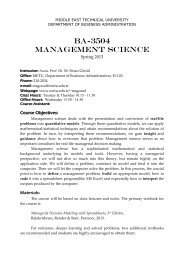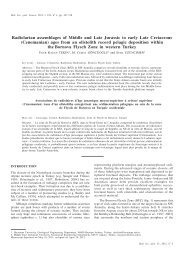CHAPTER – 1 INTRODUCTION TO PETROLEUM ENGINEERING
CHAPTER – 1 INTRODUCTION TO PETROLEUM ENGINEERING
CHAPTER – 1 INTRODUCTION TO PETROLEUM ENGINEERING
You also want an ePaper? Increase the reach of your titles
YUMPU automatically turns print PDFs into web optimized ePapers that Google loves.
1.1 Petroleum Engineering<br />
<strong>CHAPTER</strong> <strong>–</strong> 1<br />
<strong>INTRODUCTION</strong> <strong>TO</strong> <strong>PETROLEUM</strong> <strong>ENGINEERING</strong><br />
Engineering is the profession in which knowledge of mathematical and natural sciences<br />
gained by study, experience and practice applied with judgment to develop ways to utilize,<br />
economically, the materials and forces of nature for the benefit of mankind. Engineers are<br />
persons, who, by reason of their special knowledge and the use of mathematical, physical and<br />
engineering sciences and the principles and methods of engineering analysis and design, acquired<br />
by education and experience, are qualified to practice engineering. However, the most useful<br />
approach is to simply regard the engineer as a doer, a problem solver, who applies science and<br />
technology to solve the problems and meet the needs of society. The engineer is an innovator and<br />
creator of new products and processes aimed at solving problems in a practical and economic<br />
fashion.<br />
The engineer’s role is to bridge the gap between an idea and its physical reality by solving<br />
problems that exist between the two extremes, very often with little to guide him except intuition.<br />
This we have called the “creativity gap”. The tools of engineer are the scientific principles, that<br />
have been formulated about the behavior of universe and its contents. Laws of motion,<br />
thermodynamics and matter are among the tools that permit engineer to fashion a workable<br />
solution to a problem. The engineer must develop sufficient depth of understanding of the basic<br />
principles so that they indeed become like tools. He/she must be able to devote his/her efforts to<br />
building a solution to a problem and not concern himself/herself with how the tools are to be<br />
used.<br />
1
Petroleum Engineers combine chemistry, physics and geology with engineering methods<br />
in the development, recovery and field processing of petroleum. They are concerned wit finding<br />
deposits of oil and gas in quantities suitable for commercial use and with the economic extraction<br />
of these materials from the ground. The petroleum engineer will design methods for transporting<br />
oil and gas to suitable processing plants or to places where they will be used. The function of<br />
petroleum engineering is to provide a basis for the design and implementation of techniques to<br />
recover commercial quantities of natural petroleum. It is of necessity to broadly based technology<br />
drawing upon the foundations of engineering, geology, mathematics, physics, chemistry,<br />
economics and geo-statistics. As an engineering subject, it is a little anomalous in that design is<br />
based on observation of production performance and on a representation of the reservoir inferred<br />
from very limited sampling.<br />
1.2 History of Petroleum<br />
Petroleum belongs to the minerals that have been used by humanity since the earliest<br />
ages, earlier than metals and coal, and for numerous different purposes. The people and tribes<br />
who found and used these useful but unusual materials gave them many different names in their<br />
languages like “sweat of the devil”, “oil from rocks”, “shining water” and many others. Some of<br />
these names have survived thousands of years. For example: “naptha” which is coming from the<br />
“Babylonians” and “Assyrians” and petros derived from the Greek word “petros” for rock, and<br />
the Roman word petroleum for oil.<br />
Reports on petroleum and especially on the use and production of petroleum have been<br />
found in Mesopotamian libraries about 4000 years BC. For thousands of years, the only source of<br />
petroleum had been surface springs or tar pits. However most of these finds were not very<br />
productive. Therefore people began to look for oil under the earth. In Pennsylvania, Colonel<br />
2
Edwin Drake drilled 69 feet and struck oil in 1859. That day, August 27, 1859 is dated as the<br />
birthday of oil industry in USA. Even though, James Williams had completed the first<br />
commercially producing oil well one year earlier and oil seekers in Azerbaijan did the same few<br />
years earlier. Drake went one step further and he proved that oil could be obtained in sufficient<br />
quantities to meet the increasing demand by drilling through rock.<br />
1.3 Definition of Petroleum<br />
Petroleum is a mixture of naturally occurring hydrocarbons that may exist in the<br />
solid, liquid or gaseous states, depending upon the conditions of pressure and temperature to<br />
which it is subjected. Virtually all petroleum is produced from the reservoir in either liquid or<br />
gaseous form, and commonly, these materials are referred to as either crude oil or natural gas,<br />
depending upon the state of the hydrocarbon mixture. Petroleum consist of approximately 11-13<br />
wt % hydrogen and 84-87 wt % of carbon. Traces of oxygen, sulphur, nitrogen and helium may<br />
be found as impurities in crude oil. Crude oils obtained from different oil reservoirs have widely<br />
different characteristics. Some are black, heavy, and thick like tar, and others are brown or nearly<br />
clear with low viscosity and low specific gravity. However, nearly all crude oils have elemental<br />
analyses within the limits given below.<br />
Table 1-1 Elemental Analysis of Typical Crude Oils<br />
Element % by wt<br />
Carbon 84 - 87<br />
Hydrogen 11 - 14<br />
Sulphur 0.06 <strong>–</strong> 2.0<br />
Nitrogen 0.1 <strong>–</strong> 2.0<br />
Oxygen 0.1 <strong>–</strong> 2.0<br />
3
Table 1.2 Typical crude oil fractions<br />
Crude Fractions<br />
Boiling point,<br />
°F<br />
Chemical<br />
composition<br />
Use<br />
Hydrocarbon gas C1 <strong>–</strong> C4 Natural gas, bottled fuel gas<br />
Petroleum ether To 160 C5 <strong>–</strong> C6 Solvent, paint thinner, cleaner<br />
Gasoline 160 <strong>–</strong> 400 C7 <strong>–</strong> C8 Motor fuel, solvent<br />
Kerosene 400 <strong>–</strong> 575 C10 <strong>–</strong> C16 Illuminating oil, diesel fuel, jet fuel<br />
Light gas oil 575 <strong>–</strong> 850 C16 <strong>–</strong> C30<br />
Lubricating oil, mineral oil, cracking<br />
stock<br />
Heavy gas oil 850 <strong>–</strong> 1100 C30 <strong>–</strong> C50 Lubricating oil, bunker fuel<br />
Residue 1200+ C80+<br />
Tars, asphalts, wood preservatives,<br />
roofing compounds<br />
1.4 Where Does Petroleum Occur<br />
Rocks forming the earth’s crust are traditionally divided into three groups according to<br />
their origin as igneous, sedimentary and metamorphic rocks.<br />
1.4.1 Igneous Rocks<br />
Igneous rocks are formed as a result of cooling and solidifying of molten magma erupted<br />
from the earth’s interior. The rocks of this type are thought to make about 95 % of the outermost<br />
crust of the earth. They are generally hard, crystalline in structure, and are practically devoid of<br />
pore spaces or voids. Granite, basalt, andesite, serpentines, diabases are the typical examples oF<br />
this group.<br />
1.4.2 Sedimentary Rocks<br />
Sedimentary rocks are formed from the deposition of organic and inorganic matter. Fine<br />
pieces of igneous rock along with plant and animal fossils were deposited by wind or water and<br />
gradually settled in layers and strata. Sedimentary rocks are grouped into three categories as<br />
clastic, chemical and organic sediments. Clastic sediments were formed by breakdown, transport<br />
and deposition of rocks. These are gravels, conglomerates, breccia, sands, sandstone, siltstone,<br />
4
clay, clay-stone and shale. Chemical sediments are mineral salts (chlorides, sulfates, etc..),<br />
carbonates (limestone, dolomite and others) and siliceous rocks. These rocks generally have a<br />
crystalline structure. Sedimentary rocks are produced by erosion, deposition and compaction.<br />
Erosion is the gradual breaking down of larger rocks into smaller stones by the forces of nature-<br />
wind, rain, snow, ice, streams, etc.. These eroded rocks are generally carried away from their<br />
point of origin and deposited elsewhere, generally and/or ultimately on the ocean floors. As the<br />
process of deposition has continued for millions of years, the thickness of the sediment on ocean<br />
floor has reached several thousand feet. Compaction occurs as the underlying sections of<br />
sediment are compacted by the weight of new layers above.<br />
Sedimentary rocks are of two types: fragmental rocks and precipitated rocks. Fragmental<br />
rocks are made up of broken pieces of larger rocks that have been eroded by nature. Such rocks<br />
include conglomerates (rock particles, the size of marbles or larger), sandstone (particles the size<br />
of sand grains), siltstone (a mixture of very fine sand and clay) and shale (particles of clay size).<br />
Precipitated rocks are those which have been affected by chemical action, evaporation or the<br />
activity of animals and plants. Precipitated rocks include limestone, gypsum and dolomite.<br />
Conditions favoring petroleum formation are found only in sedimentary rocks<br />
1.4.3 Metamorphic Rocks<br />
Tectonic processes, which occur in a high-pressure, high-temperature environment,<br />
change the composition and the structure of original igneous and sedimentary rocks and cause the<br />
formation of metamorphic rocks. The most common of such rocks includes quartzites, shales and<br />
marble. Metamorphic rocks do not contain fossils. They resemble igneous rocks in their<br />
crystalline-grain structure and sedimentary rocks in the parallel-linear distribution of mineral<br />
grains.<br />
5
1.5 How Does Petroleum Occur<br />
There are still differences of opinions regarding the origin of oil and gas. Many theories<br />
on the origin of petroleum have been proposed and are normally classified into two general<br />
groups.<br />
1.5.1 Inorganic Theory<br />
A number of scientists adhere to the concept that inorganic oil and gas have originated in<br />
the earth’s interior as a result of chemical reactions between hydrogen and carbon under<br />
conditions of high temperature and high pressures in the absence of organic matter.<br />
1.5.2 Organic Theory<br />
The organic theory of the origin of oil <strong>–</strong> the most accepted theory- maintains that the<br />
hydrogen and carbon source for petroleum was organic material from decaying plants and<br />
animals forming and accumulating in oceanic sediment. The acceptance of the organic theory of<br />
the origin of petroleum dictates that the search for oil be directed to areas underlying by thick<br />
sections of sedimentary rock.<br />
At the present time most authorities favor the organic approach. Their principal reasons<br />
are the followings:<br />
-No inorganic theory can account for the necessary quantities of carbon and hydrogen needed to<br />
form large petroleum deposits. The abundance of plant and animal life present in sediments is a<br />
sufficient source.<br />
-Many crude oil contain <strong>–</strong>porphyrins- and nearly all contain nitrogen. The presence of these<br />
materials strongly suggests organic origin as they are present in all organic matter. Also<br />
porphyrins of vegetable origin have been found to be more plentiful than those of animal origin.<br />
6
-Petroleum rotates the plane of polarized light. This property is restricted primarily to organic<br />
materials known as optical isomers and further suggests organic matter as the source of<br />
petroleum.<br />
1.6 Formation of Petroleum<br />
The complete process of alteration whereby organic materials are transformed into<br />
petroleum is not known. The main factor, which prohibits complete laboratory verification of the<br />
theory, is the inability to reproduce the million or so years, during which the process occurs. The<br />
role of “anerobic” bacteria in promoting this alteration may be considerable. The evidence from<br />
studies of oil fields has led most geologists to the following general conclusions.<br />
-Petroleum originates from organic material, primarily vegetable, which has been altered by heat,<br />
bacterial action, pressure and other agents overlying periods of time.<br />
-Conditions favoring petroleum formation are found only in sedimentary rocks.<br />
-The principal sediments generally considered as probable source rocks are shales and limestones<br />
that were originally mud under saline water.<br />
In shallow, stagnant water basins host of blue green algae, arthropodal and planktonic<br />
organisms develop. On dying, they fall to the bottom of bodies of water along with the dust of<br />
plants and entrained fine mineral substances, and form soft, sometimes rather thick layers of<br />
organic ooze, or sapropel. The strata of sapropel and humus sediments gradually accumulate at<br />
the bottom of water basins. In these strata, the reactions of hydrolysis of fat may take place<br />
depending on the pressure, temperature, amount of oxygen and salinity of water. These reactions<br />
yield fatty acids, glycerin, and other products, which then transform into hydrocarbons (methane,<br />
napthene and aromatic types) and oxygen compounds (ketones). All these compounds dissolve in<br />
fatty acids to give a homogeneous tar like mass that remains at the bottom together with mineral<br />
7
matter (sand, clay) and is gradually covered with mineral sediments. Such a tar like accumulation<br />
can be called primary oil (protopetroleum). The conversion of organic matter into oil in a<br />
reducing medium involves chemical reactions, which tend to raise the carbon and hydrogen<br />
content and to decrease the oxygen content.<br />
It is now believed that combination of factors is necessary to transform primary organic<br />
matter into oil, such as elevated temperatures and pressures, the activity of bacteria and the action<br />
of radioactive substances.<br />
1.7 The Migration of Petroleum Hydrocarbons<br />
The main reason for the migration and the trapping of petroleum hydrocarbon in<br />
reservoirs is the existing system of static and dynamic pressures existing in the pores (such as<br />
overburden pressure - pressure due to the weight of overlying sediments an the average of 1<br />
psi/ft-). The main result of overburden pressure is the compaction of rock that will reduce the<br />
pore space and pushing the liquid content out of the core. Liquid will try to find the way out to<br />
the upper low pressure sections. During compaction water surplus of sediments will be expelled<br />
and move to zones of lower pressure carrying with it droplets of oil and gas bubbles. Under<br />
normal conditions water shows higher affinity to rock surface, the pore space then is water wet<br />
and will always retain a fine film of water covering the rock surface called “connate water”.<br />
Compaction of sediments will remain a permanent process over geologic time. The squeezed out<br />
water is kept moving for the same time even longer and the path of its migration may cover<br />
hundred of kilometers. Many of these migration paths may lead into open and the oil droplets will<br />
be lost by migration. Others will be ended by so called traps or reservoirs forming oil or gas<br />
8
fields. It may take million of years to fill such a reservoir with a considerable amount of<br />
hydrocarbons.<br />
1.8 Oil and Gas Migration<br />
After its formation, petroleum may migrate from the source rock into porous and<br />
permeable beds where it accumulates and continues its migration until finally trapped. Petroleum<br />
created from the decomposed remains of animals and plants (which were deposited and<br />
accumulated in deep sedimentary strata) finds its way to natural storage basins by traveling<br />
through porous rocks or layers of rocks. The tiny spaces or pores of sandstone or the ores or<br />
cracks of limestone, dolomite or other sedimentary rocks, form the “avenues” by which the<br />
petroleum products wind their way upward, carried by their original salt water environment. The<br />
oil, gas and water eventually stop when they reach a structure or trap, having a cap rock seal, that<br />
forms a reservoir to hold them; that is what the oil and gas industry took for in exploration<br />
operations.<br />
The capacity of rock to contain petroleum is termed porosity. The ability of the rock to<br />
permit petroleum flow is known as permeability. The forces causing the oil migration are:<br />
-compaction of sediments as depth of burial increases.<br />
-diastrophism (crustal movement causing pressure differentials and consequent subsurface fluid<br />
movement)<br />
-capillary forces (causing oil to be expelled from fine pores by preferential entry of water)<br />
-gravity (promotes fluid segregation according to density differences)<br />
Commercial crude oil and gas reserves are found mainly in sedimentary rocks (sands,<br />
sandstone, limestone and conglomerate). In igneous and metamorphic rocks oil occurs rarely and<br />
as a rule, has no commercial significance. Natural accumulations of oil and gas in the earth’s<br />
9
interior are called oil and gas reservoirs. An oil bearing reservoir (also called formation) is<br />
usually bound at the top and the bottom by impermeable rocks (clays) that do not allow oil and<br />
gas to penetrate into other strata.<br />
1.9 Traps<br />
In order for petroleum to accumulate in commercial quantities, it must, in its migration<br />
process, encounter a subsurface rock condition that halts further migration and causes the<br />
accumulation to take place. These subsurface conditions are numerous in type ranging from very<br />
simple to extremely complex forms. Numerous systems of tap classification exists where the<br />
following is an example.<br />
Figure 1-1 Sequence of Oil Deposits<br />
1.9.1 Anticline Trap: An anticline is formed when the crust folds to form a dome-shaped layer<br />
like an upside-down bowl. The dome can be a rock which will not let the oil or gas pass upwards<br />
or sideways (impervious). This is called the ‘cap rock’. It can also be a layer of clay. Notice the<br />
order of the layers in the trap. Gas is the least dense, so it rises above the oil.<br />
10
Figure 1-2 Anticline Trap<br />
1.9.2 Fault Trap: When rocks move, they may slide past each other. This changes the layers next<br />
to each other. The oil trapped in the sedimentary rock can be forced next to a layer, which will<br />
not let the oil and gas move any further.<br />
Figure 1-3 Fault Trap<br />
1.9.3 Combination Trap: An example of this type of trap is the ‘salt dome’. When a sea dried up<br />
a layer of salt was formed. Eventually, this layer became rock salt, which is impervious. Through<br />
a combination of rock movements, the salt can be forced through the layers around it to form a<br />
plug. This trapped the oil, gas and water.<br />
11
1.10 Unconformities<br />
Figure 1-4 Combination Trap<br />
An unconformity is a surface of non-depositional rock that separates the newer layers of<br />
rock from the older. Angular unconformity is the lower, older strata dip at different angle from<br />
the layer above them. Disconformities are an unconformity between the parallel strata. Non-<br />
conformity is unconformity where the older, lower layer is of plutonic or solidified molten rock<br />
origin. Petroleum is trapped in unconformities by the solid cap rock, laid across it by the cut-off<br />
surfaces of the lower beds.<br />
1.11 Measuring the properties of rocks<br />
Geologists and geophysicist work closely together using a variety of methods. All the<br />
information is carefully considered, with the help of computer analysis, before any decisions to<br />
drill are made. A geologist collects small samples of rock. Sometimes the samples of rock are<br />
dug out by hand or cylindrical cores are drilled to give samples, which can be cut and studied<br />
under a microscope. These help them to find out:<br />
12
-where the rocks have come from (their origin)<br />
-what they are made of (their composition)<br />
-how the rocks are arranged in strata.<br />
Geologists also find out about the physical and chemical properties of the rocks<br />
(mineralogy) and the fossil record from ancient times (paleontology). All these clues give<br />
information to build up a picture of the area being surveyed.<br />
A geophysicist adds to the information of a geologist by studying the physics of the earth.<br />
Surveys are made of the magnetic field, the gravity and how waves travel through the layers.<br />
1.11.1 Magnetism<br />
Magnetometers measure very small changes in the strength of the Earth’s magnetic field.<br />
Sedimentary rocks are nearly non-magnetic and igneous rocks have a stronger magnetic effect.<br />
Because of these different effects on the magnetic field, measurements can be made to work out<br />
the thickness of the sedimentary layers, which may contain oil.<br />
1.11.2 Gravity<br />
Gravimeters measure the strength of the Earth’s gravitational pull. This is not the same all<br />
over the Earth because of the different densities of the rocks. Igneous rocks like granite is denser<br />
than sedimentary rocks. Granite near the surface will have a stronger pull than the same lump<br />
deeper down, so measurements help to build up more information about the layers of rock.<br />
1.11.3 Seismic waves<br />
Shock waves or seismic waves are used to help give a picture of deep rock structures. The<br />
idea is to make artificial shock waves and record how they travel through the earth. The shock<br />
wave travels through the water and strikes the sea bed Some of the energy of the wave is<br />
13
eflected back to the hydrophones. The rest of the wave carries on until it reaches another rock<br />
layer. The time taken for the waves to travel from the source to the hydrophones is used to<br />
calculate the distance traveled - hence the thickness of the rock layers. The amplitude of the wave<br />
gives information about the density of the reflecting rock. A survey using artificial shock waves<br />
is called a seismic survey. The data from a survey is recorded and displayed by computer as a<br />
pattern of lines, called a seismograph..<br />
Figure 1-5 Seismic Waves<br />
14<br />
Prof.Dr. Mustafa Verşan KÖK







